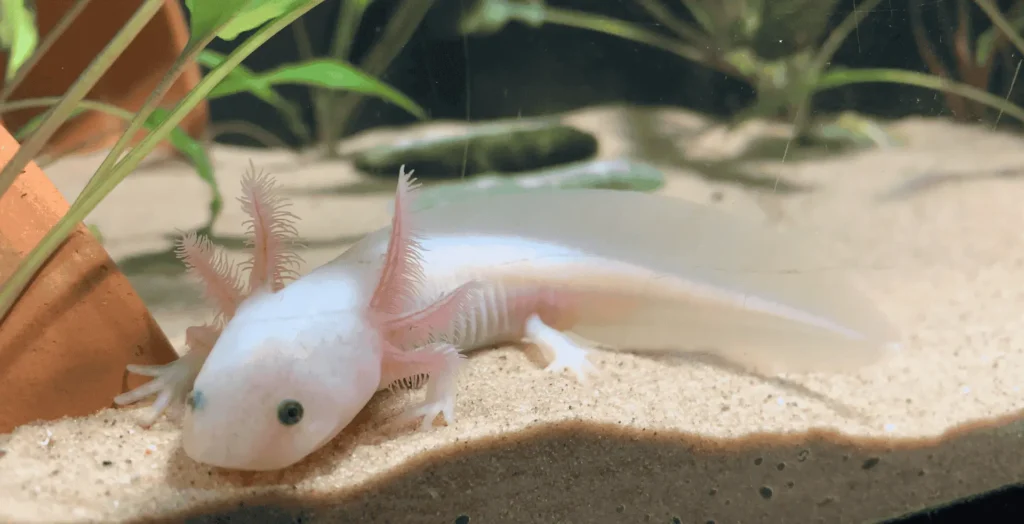If you’re considering a unique and low-maintenance animal, Axolotls—also known as Mexican walking fish—might be the right choice. These fascinating creatures have gained immense popularity in recent years, especially among pet enthusiasts. Many people first discovered them through games like Minecraft, but they are much more than just digital pets. With their frilly gills, curious smile, and gentle behavior, axolotls have become a popular choice for those looking for something a little different.
Axolotls are a type of salamander that stay in their juvenile stage for their entire life, a rare trait called neoteny. This means they retain their juvenile features, such as external gills, and never develop lungs like other amphibians. Because they lead a fully aquatic life, they do not need a land area and are completely aquatic from start to finish. They’re best kept in a tank and are not pets you handle, but they’re very entertaining to watch and interact with.

These adorable creatures come in a wide range of colors including wild brown, leucistic (a white axolotl with blue eyes), golden, albino, melanistic, and even chimera patterns. Some even carry a green fluorescent protein (GFP gene), making them glow under blue light. In captivity, axolotls can live anywhere from 10 to 15 years, with a few reaching up to 20 years under optimal conditions. This impressive lifespan makes them a long-term companion for dedicated owners.
Thanks to their docile demeanor, simple to feed diet, and low demands, they’re easy to care for and can be a great pet for individuals and families alike. With their quirky critters charm and strange appearance, they bring pet fun and joy into many homes. Their personality, gentle engagement with owners, and the behavior they show make them lovable additions to any household. If you’re still wondering whether they’re the right fit, read on to discover more about their habitat, dietary needs, and daily care.
What is an axolotl?
An axolotl is a fascinating species of salamander that lives its entire life in water, unlike most amphibians. Due to a rare condition called neoteny, it retains its juvenile features even in adulthood, such as a tadpole-like appearance, feathery gills, and a long dorsal fin. Although often mistaken for a fish, the axolotl is a uniquely amphibian creature.
In the wild and captivity, they stay fully aquatic and never walk on dry land, which has led to some confusion—many early observers even called them the Mexican walking fish. As someone who’s read through many detailed care articles, I can say the Axolotl care guide always emphasizes their delicate needs and incredible traits.
Is It Legal to Own a Pet Axolotl?
Many people wonder why are axolotls illegal in some places, especially when they seem like calm and interesting pets. The truth is, while Axolotls are fascinating and loved by pet keepers, it is illegal to own them in certain states like California, Maine, New Jersey, and Virginia. Some places such as New Mexico consider them legal to keep, but it is still illegal to import them from other regions.
These rules are tied to exotic pet laws, which aim to protect both native wildlife and the Axolotls themselves. Always verify the local laws before deciding to adopt one. Since Axolotls are native to Mexico, they are considered a critically endangered species due to loss of habitat, declining water quality, and rapid urbanization. Removing them from the wild for the pet trade is discouraged, as the majority of pet axolotls today actually descend from captive-bred animals used in scientific research.
Why Axolotls Make Good Pets
One reason many pet owners love Axolotls is because they’re both visually captivating and full of intriguing behaviors—even though their slow, inactive demeanor might suggest otherwise. In the wild, they’re clever predators that wait patiently for prey before striking swiftly.
What makes them even more appealing is that, contrary to what some think, they’re easy to care for as long as their specific needs are met, like a well-maintained, clean aquatic environment and regular feeding. Axolotls truly thrive when given proper care and make fantastic pets for all ages. Their unique appearance and easy-going nature attract both children and adults who are looking for an unusual pet to enjoy at home.
Low Maintenance
When I first got into keeping axolotls, I was surprised by how low maintenance they are compared to other aquatic animals. These unique little pets don’t require a complex setup or any expensive equipment to thrive. I started with a well-filtered tank, added some hiding spots, a suitable substrate, and even included a water cooler since my room gets warm—it turned out to be exactly
what was necessary to make a comfortable environment. One thing I truly appreciated was how simple their feeding routine is. They do well even without a varied diet, which makes the care process incredibly straightforward for beginners like me.
Docile and Calm Nature
What really makes axolotls stand out as suitable pets is their docile nature and calm behavior. From my own experience, they’re great for people of all ages, especially those who prefer quiet, peaceful creatures. They’re not aggressive and usually keep to themselves, which makes them ideal even for kids or beginners who are just starting with aquatic pets.
Even though they’re shy, axolotls have interesting behaviors that make them enjoyable to watch. Mine often interact with me during feeding time or when they’re exploring around their tank. These small moments really build a connection between the owners and their pets without the stress or effort that some other animals might require.
Fascinating Biology
One reason I’ve always loved axolotls is because they’re such unique creatures with truly fascinating biology. Unlike most animals, these little wonders are among the few animals that can regenerate lost body parts—including limbs, gills, and even parts of their heart and brain. This remarkable ability not only makes them a joy to observe.
but it also draws interest in scientific research. As someone who enjoys learning through care, having an axolotl has given me a chance to better understand and appreciate how special and fascinating a pet can be when you’re involved in their care.
Variety of Colors
One of the reasons I enjoy keeping axolotls is the amazing variety of colors they come in. From wild type to golden albino, and from melanoid (deep black) to leucistic with white skin and pink eyes, each one has a unique appearance that makes them truly visually appealing. Their frilly gills and lizard-like body give them a look that’s hard to forget. You can easily choose the one that fits your style, and no matter which you pick, they make a standout addition to any home.
Long Lifespan
If given proper care, axolotls can live for around 10-15 years, which makes them a great long-term companion. I’ve personally found it rewarding to enjoy their calm presence over many years, but it’s essential to give them the right attention to ensure they have a healthy life. With just a bit of consistent effort, these amazing creatures can be with you for a long time.
What Do Axolotls Like to Eat?
Axolotls may have a timid look and a contented smile, but they’re actually curious carnivores that love to feast on a variety of worms, insects, crustaceans, and small fish. Since they can be sensitive, it’s best to avoid anything from a garden or lake and stick to safe items bought from a trusted pet store.
Some common options in an Axolotl diet include bloodworms, jumbo bloodworms, earthworms, brine shrimp, tubifex worms, and other frozen or commercial foods. Many owners wonder, “will axolotls eat fish?” — the answer is yes, but only small fish that are safe and parasite-free.
A good Axolotl feeding schedule depends on their age and size. Young axolotls are usually fed once or twice a day, while adults need food every two to three days. Watch their tank carefully — if food stays untouched, they might not be hungry. Also, remove any uneaten food after about 24 hours to keep the water clean and reduce contamination. It’s best to use tools like round-nosed forceps to drop the food near the animal, or try feeding in the evening when they’re more active and interested.
Choosing What Food is Best For Your Axolotl? may take time. Some axolotls prefer specialized pellets, but transitioning them can be challenging. Over time, you’ll learn to monitor their weight and adjust the amount to avoid overfeeding and obesity.
which are common in captive axolotls. In the wild, they eat things like snails, amphibians, and strips of meat like beef or liver. Thankfully, supplements like vitamin or mineral powders are usually not necessary. Still, when unsure, it’s smart to consult your veterinarian about the right methods, feedings per week, and how much to offer them often.
How long do axolotls live?
How long do axolotls live depends on their care, but with the right setup, Axolotls can bring a lot of enjoyment for many years. In many cases, they live for more than 10 years, which makes them a long-term pet. Over time, these pets not only stay healthy but also grow to over a foot long, which still amazes me every time I see mine stretching out in the tank.
Conclusion
Axolotls are truly fascinating creatures and make great pets for people of all ages. Their low maintenance requirements, docile nature, fascinating biology, and variety of colors make them both enjoyable and rewarding to care for. Thanks to their long lifespan, you can share years of companionship with these charming animals.
If you’re considering adding a pet axolotl to your family, take time to prepare, educate yourself, and create the right environment for them to thrive. Their specific needs are simple to meet with proper care and attention, and they bring an exotic touch to any home. I always recommend doing thorough research and seeking expert advice from trusted staff to make your axolotl adventure a true success.
Faqs
Do axolotls like to be touched?
From my experience keeping axolotls, I’ve learned they’re not the kind of interactive pets like dogs or cats. They prefer to be handled as little as possible because frequent touch can make them stressed. Their skin is very delicate, covered in a protective slime coat that can be damaged easily. When touched, they might absorb oils or chemicals from your hands, which is potentially harming to them. So even though they’re fascinating creatures, it’s best to enjoy watching them without trying to make them behave like traditional pets.
Is it okay to have an axolotl as a pet?
Keeping axolotls as pets is definitely okay, but they do need specific care and a serious long-term commitment. From my own setup, I found them relatively easy to care for if you’re someone who prefers a less interactive companion. Their delicate nature and specific needs like cool water, a quiet environment, and a stable temperature mean they’re not suitable for everyone, especially children who may expect playful behavior.
Do axolotls like their owners?
Although axolotls don’t feel emotions or show affection the way humans do, they can learn to associate their owners with feeding times. I’ve noticed mine will come to the surface of the tank when they see me, which shows they can recognize and react to familiar behavior. However, this is more about learned behavior and association, not true liking or emotional capacity.
Are axolotls good for beginners?
While axolotls can be rewarding pets, they are usually not recommended for absolute beginners because of their specific care requirements and sensitivity to water chemistry. From my experience, keeping them healthy means maintaining a properly cycled tank, using cold temperatures often supported by a chiller, and being ready to consult a dedicated, expert vet for any health issues.

